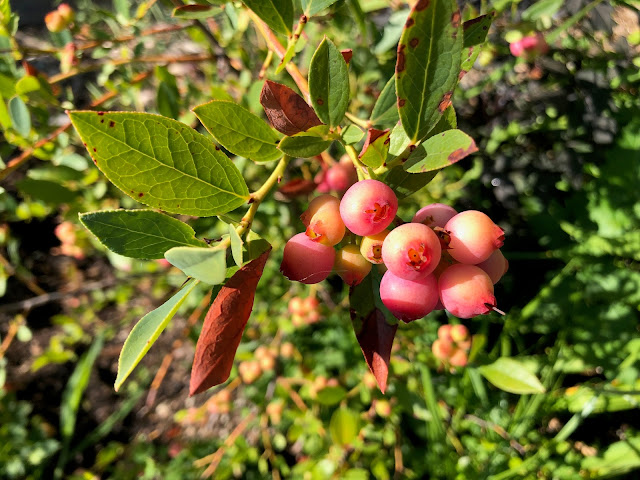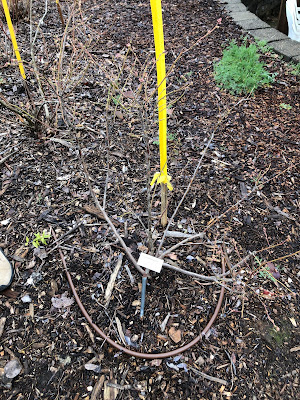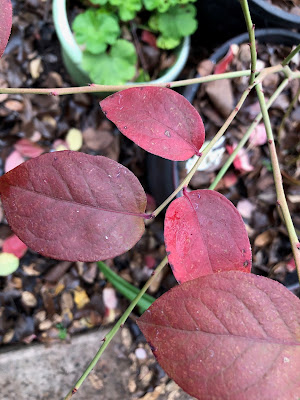
Blueberries grow well here with the right care

In normal times, the winter workshops and Open Garden at the Sacramento County master gardeners' Fair Oaks Horticulture Center would feature a lot of hands-on information about growing and pruning fruit trees and bushes, including in the Berry Garden. Alas, not this year, but a great deal of information is available online. Be sure to check that any information you find is appropriate for our climate. (Hint: Start with the master gardeners' website .)

|
|
Blueberry plants look very stark in winter -- this
is a Southmoon at the Fair Oaks Horticulture
Center -- but some produce gorgeous red leaves
in late fall. (See next photo)
|
So do a test of the soil where you plan to put your blueberry bush. Information on how to adjust the pH, in the best summary of blueberry growing I've found, is in "Growing Blueberries in the Sacramento Region," an Environmental Horticulture Note, EHN 88, written by the Sac master gardeners.
Now is a great time to shop for blueberry bushes, during bare-root season when plants are plentiful and less expensive. But not every blueberry variety does well here -- our hot summers, you know -- so the recommended varieties all fall under the category of Southern highbush, which have lower "chilling hours" requirements (hours of temperatures under 45 degrees during dormancy) in the 150-800 hour range.
(Northern highbush types have very high chilling requirements, as many as 1,000 hours, which is why they're grown as far north as Canada.)

|
|
These pretty leaves are on one of my container
plants. |
-- Sunshine Blue, Misty, O'Neal, Southmoon and Sharpblue, which are standard Southern highbush. Just 150 to 200 chilling hours required, which is why these are so popular here.
-- Peach Sorbet (300 hours) and Pink Icing (500 hours), both very pretty compact Southern highbush varieties.
-- Pink Lemonade, a stunning plant that produces sweet pink berries. It's a hybrid "rabbiteye," another category of blueberry altogether, which usually is grown in humid climates in the South. This one requires only 300 chill hours, but is reported to require another rabbiteye bush nearby.
Southern highbush varieties are self-pollinating but also often do better with another variety planted nearby. Like other fruit producers, they take a little while to get going, often best by their third year.
I have four blueberry plants -- three in pots -- and they are finally into their producing years. They'll be pruned in the next few weeks. Keeping the birds and squirrels away from the crop is my new concern, but that's a post for the spring!
Comments
0 comments have been posted.Sacramento Digs Gardening to your inbox.
Sites We Like
Garden Checklist for week of May 12
Get your gardening chores and irrigation done early in the day before temperatures rise.
* Plant, plant, plant! It’s prime planting season in the Sacramento area. Time to set out those tomato transplants along with peppers and eggplants. Pinch off any flowers on new transplants to make them concentrate on establishing roots instead of setting premature fruit.
* Direct-seed melons, cucumbers, summer squash, corn, radishes, pumpkins and annual herbs such as basil.
* Harvest cabbage, lettuce, peas and green onions. This heat will cause leafy greens and onions to flower; pick them before they bolt.
* In the flower garden, direct-seed sunflowers, cosmos, salvia, zinnias, marigolds, celosia and asters.
* Plant dahlia tubers. Other perennials to set out include verbena, coreopsis, coneflower and astilbe.
* Transplant petunias, marigolds and perennial flowers such as astilbe, columbine, coneflowers, coreopsis, dahlias, rudbeckia and verbena.
* Keep an eye out for slugs, snails, earwigs and aphids that want to dine on tender new growth.
* Feed summer bloomers with a balanced fertilizer.
* For continued bloom, cut off spent flowers on roses as well as other flowering plants.
* Got fruit trees? If you haven't already done so, thin orchard fruit such as apples, peaches, pears, pluots and plums before they grow too heavy, breaking branches or even splitting the tree. Leave the largest fruit on the branch, culling the smaller ones, and allow for 5 to 6 inches (or a hand's worth) between each fruit.
* Thin grape bunches, again leaving about 6 inches between them. For the remaining bunches, prune off the "tail" end, about the bottom third of the bunch, so that the plant's energy is concentrated in the fruit closest to the branch.
* As spring-flowering shrubs finish blooming, give them a little pruning to shape them, removing old and dead wood. Lightly trim azaleas, fuchsias and marguerites for bushier plants.
* Add mulch to the garden to help keep that precious water from evaporating. Mulch also cuts down on weeds. But don’t let it mound around the stems or trunks of trees or shrubs. Leave about a 6-inch to 1-foot circle to avoid crown rot or other problems.